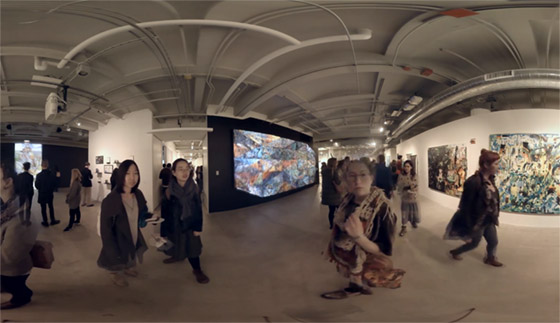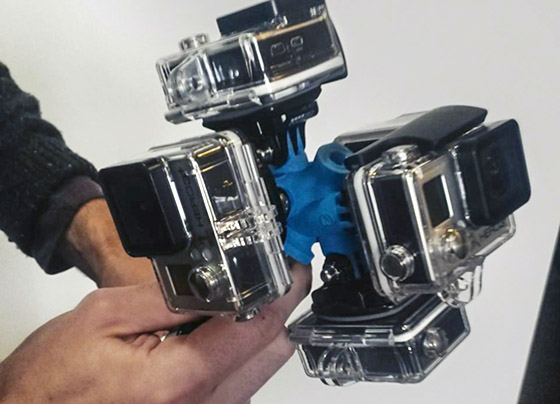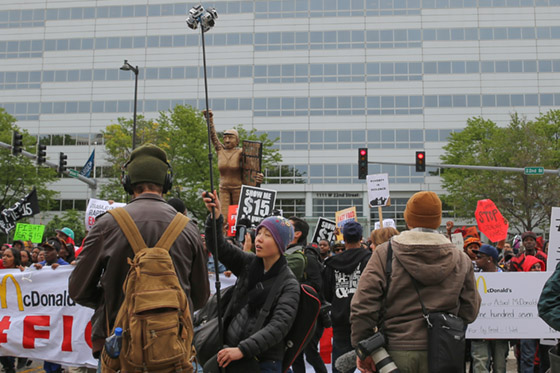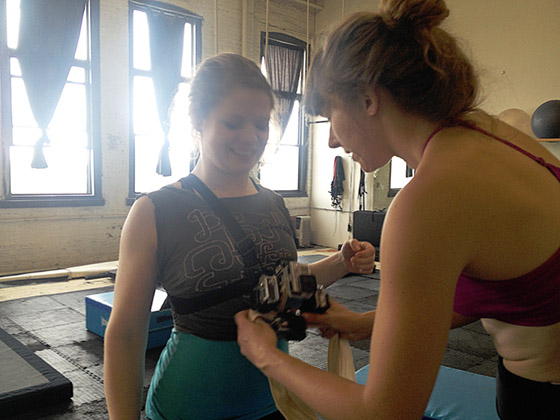| « The Aristocracy Will Bring on the Revolution in AstonRep's Les Liaisons Dangereuses | Explore Contemporary Indian Culture at Month-Long Eye on India Festival » |
Film Wed May 27 2015
Talking 360° Video with GB's The Grid

A 360° "Source" view of The Grid episode featuring the Art Institute of Chicago's MFA exhibition.
Last week, GB's short documentary series, The Grid, released three 360° videos shot with a special six-camera rig. The videos, which let you point the "camera" in any direction, were about the April 28th demonstration at the CPD headquarters, droning in the Chicago Park District and the Art Institute's recent MFA show. This week, we're talking with The Grid's Ben Kolak and Kiyomi Mino about working with this new format.
What motivated you to experiment with 360° video?
BEN: I wanted to give viewers new ways to see what I find interesting. The 360° medium demands a slower pacing to allow time for exploring within each shot. I value that slower exploration as a more democratic mode of address, compared to the rapid fire information flow that defines much video. As I've researched it, I've noticed quite a bit of fetishization around getting the stitching and color matching perfect, and since that techno-obsessive aspect of filmmaking annoys me, I wanted to take a DIY down and dirty approach -- to try to get the effect done as quickly and cheaply as possible.
What does the rig look like? How does it work?
BEN: I've heard the rig described as a "robot" or a "video ball." It's six GoPro Hero 3+ Black cameras (the cheapest models with the ProTune setting) mounted on a 3-D printed rig.

A view of the rig.
The cameras are started in unison via one click with the same remote. The real magic happens in the editing, where Autopano software analyzes and stitches together the footage from the cameras. The actual file is a 4K video (ultra high definition), with the top and bottom of the view distorted. Think of it the way a globe gets translated to a flat map, with Antarctica and the Arctic very big. You can change the viewing method on our videos to "Source" view and see what I'm talking about.
What is it like to use the rig it in the field? How do you think about filming when the camera doesn't have a single orientation?
BEN: We've been experimenting with a number of ways to mount it. The most common is putting it on a lightweight light stand or a magic arm mounted to something, then hiding behind a wall or tree or to get out of the shot. The hiding part is difficult -- a lot of times we don't bother, or it's not an option. Our presence is something we're experimenting with -- whether to make the pieces more "host-driven," and the degree to which keeping the filmmakers in view is better on account of being more transparent and Brechtian about the means of production. One of the ideas we've been toying with is a Where's Waldo approach -- to make a challenge or a part of the piece to spot the filmmaker. We've also made a body mount -- basically a backpack with a boompole on the subject's back. I prefer that method, although it asks a lot of one's subject to wear a backpack with a pole and video ball on top -- but it makes for a great shot. There is one of these shots in the drone meetup piece, and we have a lot more of it in other pieces we're still working on.

Kiyomi filming with the rig at a recent event.
Things got a little hairy during the demonstration. How did you handle having the rig in that setting?
KIYOMI: Usually as a filmmaker, you have to schmooze and/or ruffle a few feathers to gain access to people and places. However, people were so fascinated and reverent towards the 360 camera rig, this strange new whimsical contraption, that protestors gave me plenty of leeway in moving around the crowd for good shots and interviews. It was sweet.
When the scuffle took place, I wasn't too worried about the rig getting tousled since all the cameras are in hard cases. I was more scared about bopping someone in the head with the rig and concerned about one of the cameras dying; the whole 360 shot is completely useless without all six cameras rolling together.
I was also constantly conflicted between avoiding getting my gear confiscated by following police orders to stay on the sidewalk or just going with the crowd into the streets to get closer to the action. While this kind of hesitation would have been pretty detrimental to someone with a regular camera, I later learned that with a 360 video rig it's actually good to have some distance between you and your subject to prevent ghosting and distortion. So I guess my naiveté and awkwardness helped in the end.
The CPD demonstration episode.
How do you approach editing the footage?
BEN: The stitching takes weeks! It takes a few hours for each minute of footage. We're investing in a more powerful computer, so hopefully that should cut down the stitching time. We've been thinking of the structure as audio driven: introducing the subject, and then going deeper through the nuances, and ending with a poignant and summarizing remark. The visuals have played a more open role due to the inherent challenges of not knowing where the viewer will be looking at any time. They relate to the trajectory of the pieces but don't define it.
KIYOMI: Sound editing is crucial in 360 video to transport the audience to the scene before them. Visuals alone can't do that. Audio usually takes a backseat in most filmmaker's work so it's refreshing to improve our skills in this area through 360 video production.
Is there a subject with which you'd like to experiment?
BEN: Since you used the verb like, we'd like to get access to the Independent Police Review Authority or Cook County Hospital Emergency Room, but don't think either is likely to happen anytime soon. Other candidates we feel more hopeful about include the Amateur Hockey Leagues at Johnny's Icehouse or the Commercial Club of Chicago.
What's next?
BEN: We shot a piece about the Fight for $15 protest at McDonald's headquarters last week. It's our first experiment with a host, by which I mean it features one of our collaborators, Mojo Lorwin, inquiring into the motivations and concerns of the protesters. We've been working on a piece on Aloft Loft circus school for months, with longtime collaborator Courtney Prokopas, who is currently studying there full-time. Circus seems like the perfect spectacle for this medium, and the community there really shares our DIY and innovative values -- that one is going to be a real shot in the eyes.

Collaborator Courtney Prokopas mounts the rig on a participant at Aloft Loft.
KIYOMI: I'm really excited about getting these videos onto people's smartphones rather than having people experience them on the computer. There is an app for Kolor, the video embedding service we used for the 360° videos, that makes use of its sensors to look around, but it seems either the smartphone web connection or processing can't quite handle the 4K files just yet since it buffers a lot. Once we figure it out a solution, the audience would be able to move around the environment more smoothly without fiddling with the mouse.
~*~
Kiyomi Mino is an undergraduate at Bowdoin College and an emerging documentary filmmaker. Ben Kolak is a Chicago-based documentary filmmaker and principal at Scrappers Film Group. See more of their work, 360° and otherwise, in The Grid.








